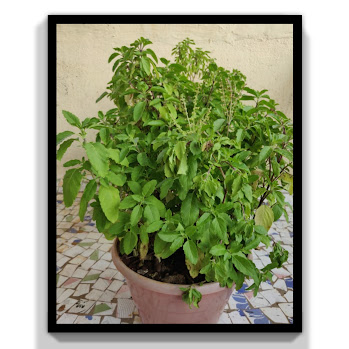How to Care and Propagate: Tulsi Plant
Introduction:
- Tulsi or Holy Basil is also known as the ‘Queen of Herbs” and the ‘Elixir of Life”.
- Tulsi is a sacred plant in Hindu belief. Hindus regard it as an earthly manifestation of the goddess Tulsi; she is regarded as the avatar of Lakshmi, thus the god Vishnu consort.
- Many Hindus have Tulsi plants growing in front of or near their home, often in special pots or a special masonry structure
- Tulsi is a perennial in tropical and subtropical regions.
- Tulsi is mostly used as a medicinal herb for the treatment of numbers of diseases from headaches to cancer.
- Tulsi is known to purify the surrounding air.
Types of Tulsi:
- Mostly there are 4 types of Tulsi Found in the Tropical region.
- Ram Tulsi: The leaves of this variety are light green in color and a little asymmetric.
- Krishna Tulsi: Also known as Shyam Tulsi, where Leaves and Stems are purple. This variety has more medicinal uses than Ram Tulsi.
- Van Tulsi: This variety of Tulsi usually grown in gardens, as it can get tall, bushy, and is quite hardy. Leaves of Van Tulsi has a velvety texture with a distinct aroma which is used in making teas.
- Kapoor Tulsi: It is normally used for medicinal purposes.
Soil:
- Tulsi Plant likes moist soil all time but not soggy.
- The ideal soil mix should be 40% Garden Soil, 20% Dry Leaves, 20% Cocopeat, 10% ash, and 10% Organic Compost.
Fertilizer:
- Tulsi requires fertile soils to thrive, especially if you are regularly harvesting leaves for tea or any medicinal use. Be sure to supplement with compost.
- Fertilizer should be provided once in three months for good results.
- Use Neem oil once in 14 days to avoid pest attack.
Climate:
- Tulsi Plant can survive between 20’c ~ 39’c temperatures.
- In ideal conditions, Tulsi requires 6 hours of sunlight per day. It can also survive part sunlight conditions, with as little as 4 hours of direct sunlight per day.
- In the winter season, it is advisable to move your Tulsi plant in full direct sunlight as this is a period where it goes in the dormant phase.
- In the summer season, one can keep the plant in such a place where it gets early morning sunlight till 11am.
Watering:
- If you wish to boost the life span of the Tulsi plant, make sure not to overwater it. In fact, let the soil dry before watering it again. Moreover, water the plant less frequently in the rainy season.
Propagation:
- Tulsi is a perennial herb and is very easy to grow.
- You can grow it from seeds but make sure that the soil is well-drained and moist.
Benefits:
- Tulsi leaves are rich in vitamins A, C, and K and minerals like calcium, magnesium, phosphorus, iron, and potassium. It also has a good amount of protein and fiber.
- Natural Immunity Booster: Tulsi is rich in Vitamin C and zinc. It thus acts as a natural immunity booster and keeps infections at bay.
- Reduces Fever (antipyretic) & Pain(analgesic): Tulsi has anti-bacterial and anti-viral properties which help to fight infections, thus reducing fever.
- Reduces Cold, Cough & Other Respiratory Disorders: Juice of Tulsi leaves mixed with honey and ginger is effective in bronchitis, asthma, influenza, cough, and cold.
- Reduces Stress & Blood Pressure: Tulsi contains compounds Ocimumosides A and B. These compounds reduce stress and balance the neurotransmitters serotonin and dopamine in the brain. The anti-inflammatory properties of Tulsi reduce inflammation and blood pressure.
- Anti-cancer properties: Phytochemicals present in Tulsi have strong antioxidant properties. Thus, they help in protecting us from skin, liver, oral, and lung cancers.
- Good for Diabetes Patients: Extract of Tulsi leaves has shown to lower blood glucose levels in patients with type 2 Diabetes.
- Useful in treating Kidney stones: Tulsi detoxifies the body and has diuretic properties. It decreases the level of uric acid in the body, which is the main reason why kidney stones are formed.
- Useful in Gastrointestinal Disorders: Tulsi leaves help to cure indigestion and loss of appetite. They are also used for the treatment of flatulence and bloating.
- Good for Skin & Hair: Tulsi helps clear out the skin of blemishes and acne. It is rich in antioxidants, and that helps it to prevent premature aging. Tulsi also strengthens our hair roots, thus preventing hair loss.
- Acts as an Insect Repellent: For centuries, the dried Tulsi leaves have been mixed with stored grains to repel insects.
Vital Tips:
- Prune the dried leaves and seeds whenever you can, as pruning the plant helps in reviving it.
- Pinch off the growing tip of your Tulsi if you wish to grow a bushy plant rather than a single stem.
- Keep removing the new flowering heads, do not let your plant flower early, and delay the Tulsi flowering as much as you can to keep your plant green, leafy & bushy.
- Always keep the pot aerated by loosening the soil, don’t let the soil get all compact & hard.
- When grown in poor conditions it might be attacked by some common pests like mealy bugs, aphids, spider mites, and sometimes whiteflies. For treating pests use Neem based organic pesticide or insecticidal soap






Comments
Post a Comment